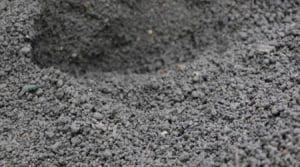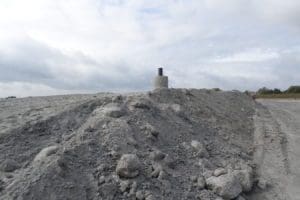The conversion of waste to energy uses an incineration process to burn energy to produce heat and create steam. Then the steam turns a steam turbine which generates electricity in the same way that it would in a coal plant or nuclear energy plant.
However, if you’ve ever had a coal BBQ or had a bonfire, you’ll know that burning something leaves behind ash. Incineration is a more complete burning process than a BBQ or bonfire, but it still leaves considerable ash which needs to be dealt with. On average, the ash is 10% of the volume of the input, and around 30% of its weight.
There are 2 primary forms of ash left over from waste to energy incineration:
- Incinerator Bottom Ash (IBA)
- Air Pollution Control Residues (APC), also known as Fly Ash.
These two different kinds of ash are picked up at different points in the incineration process and are disposed of and used in different ways.
INCINERATOR BOTTOM ASH
Incinerator Bottom Ash is the ash from the bottom of the incinerator. You might expect that this waste is simply sent to landfill, with the successful job done of reducing its weight and size to 30% and 10% respectively.
However, these unburnt remains from the combustion process contain a lot of value that can be removed, re-used and recycled. Your everyday municipal waste is surprisingly full of things that don’t burn, such as broken porcelain, glass, and metal. Additionally, the incineration process leaves ash behind, no matter how complete the process is.
The remains are funnelled out of the incinerator to be recycled further. Firstly, the ash is sent past a heavy duty magnet, which picks out any ferrous metals – such as steel, iron etc – that might be in the mix.
What’s left is then sent past “eddy current separators”. Eddy current separators use spinning magnets to induce an electric current (and therefore magnetic field) in the otherwise non-magnetic metals. This allows them to be separated from the rest of the waste similarly to how ferrous metals were removed in previous steps.
The removed metals are then recycled. What remains is a mixture of ash and secondary aggregate which is used in construction. The secondary aggregate is commonly used as bulk fill (areas that simply need filling with something), asphalt, cement bound materials, lightweight blocks (breeze blocks).
AIR POLLUTION CONTROL RESIDUES
This ash is taken out of the fumes that come from the incineration process. Removing this ash is done through a number of different chemical and physical treatment processes to ensure that the final gas which leaves the factory is just water vapour and Co2, i.e. completely safe for the surrounding population.
As the flue gasses leave the furnace and begin heating water for steam the ash begins to settle. At every stage in the energy production process, the ash is allowed to settle, and it carried away with the rest of the fly ash. Any ash that remains airborne in the flue is treated in a number of different ways. Firstly, the gas is treated with activated carbon which is incredibly porous and absorbs heavy metals in the gas, such as cadmium and mercury. It’s then treated with lime, to neutralise the acidic combustion gasses. The by-product of this process is gypsum.
Finally, the gasses are passed through finer and finer filtration bags, which remove the still airborne fly ash from the process.
The result is a finely particled ash. Fly ash on its own is classed as a hazardous material, due to the number of chemicals and compounds found in it, which may leech into the surrounding areas. However, with further thermal treatment the materials can be rendered safe and suitable as a construction material.
The process is called plasma vitrification, which uses plasma to break the complex hydrocarbon molecules into simpler, less volatile compounds harmful to the environment.
Using these processes, the entirety of the waste previously sent to landfill could be used for beneficial means, from creating energy to being used as building blocks. Compare this to allowing the waste to be sent to landfill where it releases harmful methane and takes up space.


